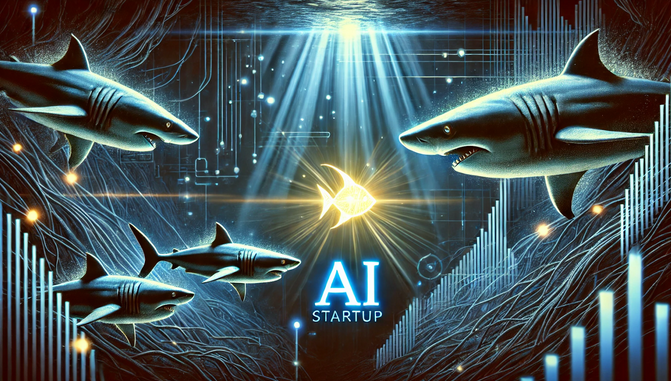(MSFT), (NVDA), (UBER), (AMD), (INTC), (QCOM), (TSM), (GOOGL)
I have always been a sucker for the small fish that big sharks circle around, especially when those sharks have names like NVIDIA (NVDA) and Uber (UBER). Believe me, after all these decades swimming in the turbulent waters of the hedge fund world, you learn to pay attention to who sidles up to whom.
So when NVIDIA, which controls roughly 80% of the AI chip market and has sent record revenue zinging through its data center division, and Uber, the swaggering king of ride-sharing with a solid 76% market share, both take a shine to a tiny AI startup, I start sniffing around. And I mean really sniffing around.
It’s like looking at a painting’s back corners instead of just the center – that’s where you find the real brushstrokes and hidden signatures. Remember, NVIDIA and Uber aren’t the sort of outfits that drop their change in a random tip jar.
They’re placing bets on a startup that’s fiddling with real-time edge computing. Think rapid-fire data processing right where the action is, no waiting for some distant server to give a nod.
They’re doing it now, quietly, and if that doesn’t catch your attention, nothing will.
Look, I can almost hear you muttering: “Why care about the kid in the corner when you’ve got NVIDIA’s big top show dominating the AI scene?” Remember, Microsoft (MSFT) purchased a staggering 485,000 of NVIDIA’s Hopper AI chips in 2024 alone.
That’s more than double what other US and Chinese competitors managed to grab. If that doesn’t underline NVIDIA’s chokehold on supply, what does?
Uber, which has pumped over $1 billion since 2015 into making cars steer themselves and optimize logistics, clearly plans for a future when autonomous everything is as common as a traffic jam in Manhattan. Linking up with this under-the-radar AI whiz kid might give Uber more finely tuned algorithms, more efficient fleets, and a fatter bottom line.
Still, there’s a lot of chatter right now. Everyone’s yapping about AI as if it’s the cure for every market hangover.
So let’s sink our teeth into something more satisfying: the numbers. The AI chip market, valued at about $53.7 billion in 2023, is expected to top $71 billion in 2024.
Meanwhile, the global autonomous vehicle market, already a hulking $1,500.3 billion in 2022, is forecast to explode to $13,632.4 billion by 2030. That’s a compound annual growth rate of 32.3%.
The direction is screamingly obvious. Everyone, including NVIDIA and Uber, wants a piece.
Their quiet investment in this tiny startup is a subtle tip-off that something big is percolating just beneath the surface.
I’m no stranger to turning over stones others ignore. Over the years, I’ve watched AMD (AMD) and Intel (INTC) spar behind the scenes.
AMD holds an 11% share of the data center AI chip market—tiny next to NVIDIA, yet not negligible. Intel, with a 22% chunk, tries to catch a train that’s already leaving the station.
Qualcomm (QCOM) works the edges with mobile processors and real-time capabilities but doesn’t challenge NVIDIA’s core dominance. TSMC (TSM) quietly churns out the silicon that keeps everyone’s ambitions alive.
Alphabet (GOOGL) and Microsoft, meanwhile, drive demand through software and R&D, pushing everyone toward more powerful chips. All that said, none of these players truly compare to NVIDIA’s entrenched position.
That’s what makes this move with Uber so telling. No one said the race would be tidy.
Companies bump elbows and occasionally whisper sweet nothings into a promising startup’s ear. NVIDIA wouldn’t bother unless it foresaw future profits.
Uber wouldn’t team up unless it sensed this tech could improve its bottom line.
I’ve seen this before. Early believers in a small disruptor can reap big rewards while skeptics mutter into their coffee.
This could be another one of those moments. For those who like to keep their fingers on the pulse, NVIDIA's position is so dominant that I'd still call it a buy.
AMD is worth picking up too, considering it's stubbornly carving out territory. Intel might need to show us more before getting a seat at the table.
TSMC is the machine that keeps the AI train rolling, making it a buy for anyone with a penchant for stable back-end players. Alphabet and Microsoft, both deeply committed to AI research and application, look like buys as well.
Uber, for all its ambition, stays at hold. I love the swagger, but let's see if it can turn these investments into real profits.
I’ve seen this story before. Early believers in small disruptors can reap big rewards while skeptics mutter into their coffee.
Sometimes the tastiest morsels come from watching which small fish the giants eye for dinner. And this little AI startup? It just might be the plankton that feeds the whales.

